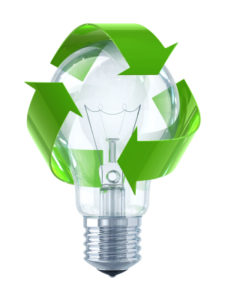
Greening Your Business
 In today’s era of escalating energy costs and climate change, energy efficiency is the most important aspect of greening your business.
In today’s era of escalating energy costs and climate change, energy efficiency is the most important aspect of greening your business.
You can reap immediate savings by lowering your overall energy use and doing so will automatically reduce your business’s carbon emission footprint.
You can also save money in the areas of waste reduction, equipment use, transportation, and building design.
Here are 21 green business tips that you can institute quickly and easily in your own business:
Tips to Keep Your Business Green
1.
Set a company policy to shut off all lights, machinery, and equipment when not in use, particularly on nights and weekends. Much equipment is idle and unused for up to 90 percent of its life. Simple inexpensive timer devices can be used to accomplish this task easily.
2.
Install low-cost energy monitors that can provide an accurate display of the cost and energy use of individual equipment. Research shows that this step alone can lead to energy savings of up to 40 percent. See, for example, www.powermeterstore.com.
3.
Consider using energy-efficient power strips or surge protectors. The latest versions can be found with remote control shut-offs, main shut-offs that can power down peripheral equipment, and motion-detecting shut-offs.
4.
Lighting can often account for up to 40 percent of energy costs for many businesses. Install motion-sensor and/or automatic dimming switches for all lighting to be certain that you are not inefficiently lighting areas when no one is present.
5.
A very cost-effective upgrade is to replace all of your incandescent lighting with new LED or compact fluorescent bulbs. Your older 1.5″ diameter fluorescent tube lighting should also be replaced with newer 1″ tubes and solid-state electronic ballasts.
6.
Install programmable thermostats to automate your HVAC system and to significantly scale back your heating and cooling when your business is not in operation. About 6 months of energy savings generally pay the installation and cost of these units, an excellent return on your investment.
7.
Use fans in your business. Comfort is a function of temperature, humidity, and air movement. Thermostat settings of 3 to 5 degrees higher can feel as comfortable with fans.
8.
Upgrade the energy efficiency of your older equipment. Modern equipment is much more energy efficient, often with less than half the energy use of older equipment. High-efficiency upgrades for motors and drives for equipment, air compressors, lighting, and other energy-consuming equipment generally have rapid payback periods, often less than one year.
9.
Always buy Energy Star qualified products for your business. The Energy Star label indicates the most efficient light bulbs, computers, printers, copiers, refrigerators, televisions, windows, thermostats, ceiling fans, and other appliances and equipment. See www.energystar.gov.
10.
Travel and transportation costs have been rising rapidly as fuel costs increase. Efficiency in transportation is often an effective way to lower your energy costs. If your business has company-owned cars or a fleet of vehicles, consider purchasing vehicles that are hybrid, whenever possible.
11.
If your company ships products or is a truck or rail company that delivers these products, look into the EPA SmartWay Transport Partnership. This is an innovative collaboration between EPA and the freight industry to increase energy efficiency while significantly reducing greenhouse gases and air pollution. Hundreds of businesses are benefiting from this partnership. See www.epa.gov/smartway.
12.
Develop a company-wide policy to eliminate unnecessary idling of truck engines. One way is by installing auxiliary power units that will heat or cool the truck when stopped, allowing the main engine to be shut down. Wal-Mart installed auxiliary power units on its 6,845 semi tractors and saved $22 million in 16 months.
13.
Many areas in the U.S. are facing rising water and sewer costs. Better water efficiency can be attained with relatively simple and low-cost steps. For example, check your facility carefully for any water leaks. If feasible, shut off all water-using outlets and monitor your water meter. If meter is showing water input, you have leaks in your system. Locate and repair any such leaks.
14.
Eliminate unnecessary wash-downs or cleaning. Install pressure reducing valves if necessary to reduce high water pressure. This can reduce water use when high-pressure water is unnecessary for a particular use.
15.
Install low-flow showers, faucets, toilets, urinals, hose valves, etc. Zero-water urinals, 1 gpf toilets, and .5 gmp faucets are all readily available and can save a significant amount of water every year. Use Energy Star certified equipment whenever possible to insure the highest efficiency.
16.
Computers and their peripherals consume a surprising amount of power. Consider using laptops as desktop computers. Laptops are far more energy efficient and can consume up to 80 percent less energy than equivalent desktops. Inkjet printers use 75 percent to 90 percent less energy than laser printers.
17.
Turn your computers off when they are not needed. It does not harm modern computers to be turned on and off repeatedly. Enable power management modes on your computer. These features allow computers to go into lower-energy modes after a certain amount of time. Sleep modes can save up to 90 percent of the energy consumed.
18.
Any waste that your company generates is an unnecessary cost. Waste is simply inefficient. Examine all waste generated by your business and look for ways any current waste products can be reused on-site or by other businesses, eliminated, or radically reduced. Brainstorm with the employees who are involved in the generation of the waste for fresh ideas. Look for ways to alter your waste generation so that the waste produced can be reused.
19.
You can incorporate green business practices into your supply chain by incorporating green specifications into bid or quote requirements where appropriate. For example, you can specify that products contain no hazardous chemicals, that they do contain post-consumer recycled content, or that all plastic components are not painted or varnished, or that all electronics equipment be Energy Star certified. See www.energystar.gov
20.
Your business facility itself can be a source of excellent energy savings. Plug all leaks in your building’s outer shell with weather stripping or caulking. Use expandable foam to fill any gaps. If you will be remodeling or building a new facility, check the LEED standards for the latest efficiency techniques. See the U.S. Green Building Council website www.usgbc.org for more information.
21.
Consider developing a comprehensive green business plan for your business that encompasses energy and water efficiency, waste reduction, transportation, computing and equipment efficiency, building design, and the design and actual operation of your business. Energy savings of 30 percent are easy and cost-effective to achieve and can reach up to 75 percent with a diligent effort.













